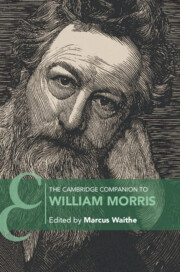Book contents
- The Cambridge Companion to William Morris
- The Cambridge Companion to William Morris
- Copyright page
- Dedication
- Contents
- Figures
- Notes on Contributors
- Acknowledgements
- Note on The Collected Works
- Chronology
- Abbreviations
- Introduction
- Part I Senses of Place
- Part II Authorship
- Part III The Practical Arts
- Part IV Movements and Causes
- Chapter 15 Practical Socialism
- Chapter 16 Morris and the Arts and Crafts Movement
- Chapter 17 Female Fellowship
- Chapter 18 Landscape and Environment
- Part V Influences and Legacies
- Guide to Further Reading
- Index
- Cambridge Companions To …
Chapter 18 - Landscape and Environment
from Part IV - Movements and Causes
Published online by Cambridge University Press: 03 May 2024
- The Cambridge Companion to William Morris
- The Cambridge Companion to William Morris
- Copyright page
- Dedication
- Contents
- Figures
- Notes on Contributors
- Acknowledgements
- Note on The Collected Works
- Chronology
- Abbreviations
- Introduction
- Part I Senses of Place
- Part II Authorship
- Part III The Practical Arts
- Part IV Movements and Causes
- Chapter 15 Practical Socialism
- Chapter 16 Morris and the Arts and Crafts Movement
- Chapter 17 Female Fellowship
- Chapter 18 Landscape and Environment
- Part V Influences and Legacies
- Guide to Further Reading
- Index
- Cambridge Companions To …
Summary
William Morris was among the most prescient of ecological thinkers in Victorian arts and literature and his work offers a searing appraisal of industrialism from within the context of its epochal rise. During this time Britain and its Empire saw major transformations in the natural world and in human relations to it, and living in the context of the first fully fossil-fuel-powered society, Victorian writers and artists were the first to observe the impacts of coal-fired industry and render them into art. Only a few authors, however, including Morris, channelled such observations into a full-throated critique of what was lost and diminished in the process of industrialization. This chapter draws on Mikhail Bakhtin, Amitav Ghosh, and other theorists of narrative to explore how News from Nowhere, The Wood Beyond the World, and other works by Morris draw on older literary depictions of the human place in the natural world. In the longer history of art and literature, landscape and nature were not always conceived as a mere backdrop to human drama, though this was increasingly the tendency in modern literature. Morris’s work challenged this tendency by drawing on older forms to produce an ecological vision that, paradoxically, feels remarkably timely today.
- Type
- Chapter
- Information
- The Cambridge Companion to William Morris , pp. 245 - 256Publisher: Cambridge University PressPrint publication year: 2024



